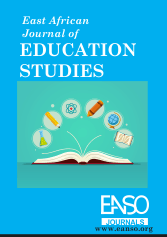Effects of Pupils’ Transfers on Academic Performance in Public Primary Schools in Kimilili Sub-County, Kenya
Abstract
In public schools, particularly in Kimilili Sub-County, student transfers are commonplace; nevertheless, the results of current empirical research on the impact of these transfers on students' academic performance are inconclusive. This study assessed the effects of student transfers on academic performance in public primary schools in Kimilili Sub-County, Kenya, because academic performance in public schools in the sub-county has been below average and the influence of these transfers on academic performance are not known. The research accomplished two goals: determined the impact of psychological factors on students' academic performance and ascertained the influence of social factors on the academic performance of transferred students in public primary schools respectively. The study used a mixed methods approach with a target population of 470 head teachers, 150 class teachers, and 308 pupils who transferred to different public primary schools. Data was collected through questionnaires, focused group discussions, and key informant interviews. The study used SPSS for quantitative analysis and thematic analysis for qualitative analysis. The Cronbach Alpha coefficient method confirmed questionnaire reliability, and expert evaluation confirmed content and construct validity. The study found that social and psychological factors significantly impact students' academic performance. The Pearsons correlation coefficient method yielded (r=0.671, p=0.001< 0.05) for social factors and (r= 0.714, p=0.000 < 0.05) for psychological factors respectively. Qualitative data also confirmed the results. These findings are crucial for addressing challenges faced by students and contribute to existing literature on pupils’ transfers and academic performance especially in public primary schools. Based on these findings, schools, TSC, and Ministry of Education should develop guidelines for transferred pupils, strengthen guidance and counseling programs, and build teacher capacity. This study supports further research on the influence of pupils’ transfers on their academic performance in private primary schools
Downloads
References
Alexander, K. L., Entwisle, D. R., & Dauber, S. L. (1996). Children in motion: School transfers and elementary school performance. The Journal of Educational Research, 90(1), 3-12.
Beharu, W. T. (2018) Psychological Factors Affecting Students’ Academic Performance among Freshman Psychology Students in Dire Dawa University.
Bold, T., Kimenyi, M. S., & Sandefur, J. (2013). Public and Private Provision of education in Kenya. Journal of African economies, 22(2), 39-56.
Creswell, J. W. (2013). Research design: Qualitative, quantitative, and mixed methods approach (4th ed.). Los Angeles, CA: Sage.
Creswell, J. W., & Plano Clark, V. L. (2018). Designing and Conducting Mixed Methods Research (3rd ed.). Sage Publications.
Han, S. (2014). School Mobility and Students' Academic and Behavioral Outcomes. International Journal of Education Policy and Leadership, 9(6), n6.
Harkeness,S., Super, C.M., Moscardino, U., Rha, J.H., Blom, M.J.M., Hutron, B., et-al. (2007). Cultural models and developmental agendas: Implications for arousal and self-regulation in early infancy. Journal of Developmental Processes, 1(2) 5-39.
Howland, A., Chen, L. T., Chen, M. E., & Min, M. (2017). Exploring socio-demographics, mobility, and living arrangement as risk factors for academic performance among children experiencing homelessness. Preventing School Failure: Alternative Education for Children and Youth, 61(4), 268-279.Kothari, C. R., & Garg, G. (2014). Research Methodology: Methods and Techniques. New Delhi: New Age International Publishers.
Lucas, A. M., & Mbiti, I. M. (2012). Access, sorting, and achievement: The short-run effects of free primary education in Kenya. American Economic Journal: Applied Economics, 4(4), 226-53.
Measor, L., & Woods, P. (2019). Changing schools: Pupil perspectives on transfer to a comprehensive. Routledge.
Mugenda, O. M. & Mugenda, A. G. (2012). Research methods: quantitative and qualitative approaches. Acts Press, Nairobi.Muralidharan, K &Sundararaman, V (2015). The Aggregate Effect of School Choice: Evidence from a Two-Stage Experiment in India. The Quarterly Journal of Economics, 130 (3), Pp 1011–1066, https://doi.org/10.1093/qje/qjv013
Nyakundi, M.G., & Orodho, J.A. (2020). Influence of Competence on Performance of Teachers in Public Secondary Schools in Kisii County-Kenya.Journal of Education and Practice, 11(3). www.iiste.org ISSN 2222-1735 (Paper) ISSN 2222-288X (Online)
OECD (2018), Engaging Young Children: Lessons from Research about Quality in Early Childhood education and Care, Starting Strong, OECD Publishing, Paris. Http://dx.doi.org/10.1787/97892664085155-en
Oketch, M., Mutisya, M., Ngware, M., Ezeh, A. C., & Epari, C. (2010). Free primary education policy and pupil school mobility in urban Kenya. International Journal of Educational Research, 49(6), 173-183.
Olaniyan, D.A & Obadara, O.E (2008). A critical review of management of Primary education in Nigeria. International Journal of African and African American Studies. Vol. VII. 1:123- 141
Republic of Kenya. (2019). Sessional Paper No. 1 of 2019 on a policy framework for reforming education and training for sustainable development in Kenya. Nairobi: https://www.education.go.ke/index.php/downloads/file/643-sessional-paper-no-1-of-2019
Rose, J., and Wood, F (2016). Child Development. In D. Wyse and S. Rogers (eds). A Guide to Early Years and Primary Teaching. London: Sage, pp. 85-104
Rumberger, R. W., Larson KA(1998). Student mobility and the increased risk of high school dropout. American Journal of Education, 107(1):1–35.
Rumberger, R. (2003). The Causes and Consequences of Student Mobility. The Journal of Negro Education, 72(1), 6-21. doi:10.2307/3211287
Salameh, W. (2012). The impact of social and economic factors on students’ English language performance in EFL classrooms in Dubai public secondary schools (Doctoral dissertation, The British University in Dubai (BUiD)).
Spilt, J.L., and Koomen, H.M.Y. (2009). Widening the View on Teacher-Child Relationships: Teachers’ Narratives Concerning Disruptive and Nondisruptive Children. Sch. Psychol. Rev. 38(1), 86-101. Doi: 10.1080/02796015.2009.12087851
Taniguchi, K. (2017). Determinants of student mobility in primary school in rural Malawi: an event history analysis. World J. Educ., 7 (2), 19-30.
Thompson-Griffith, B. J. (2015). Student mobility and how it impacts the academic achievement gap (Doctoral dissertation, Mississippi College).
Thomson, S. (2018). Achievement at school and socioeconomic background—an educational perspective.
Trujillo, G. A. (2018). Resident Parents' Perception and Attitudes toward Open Enrolment, Inter-district Pupil Transfer Practices (Doctoral dissertation, Texas A&M University-Commerce).
Wentzel, M.,& Tlabela, K. (2006). Historical Backgrounds to Southern African Migration.In P. Kok, D. Gelderblom, J. Oucho, &J. Van Zyl. (eds.). Migration in South and Southern Africa: Dynamics and Determinants, Cape Town, South Africa, Human Sciences Research council.
Copyright (c) 2024 Leopard Jacob Mwalongo

This work is licensed under a Creative Commons Attribution 4.0 International License.




























